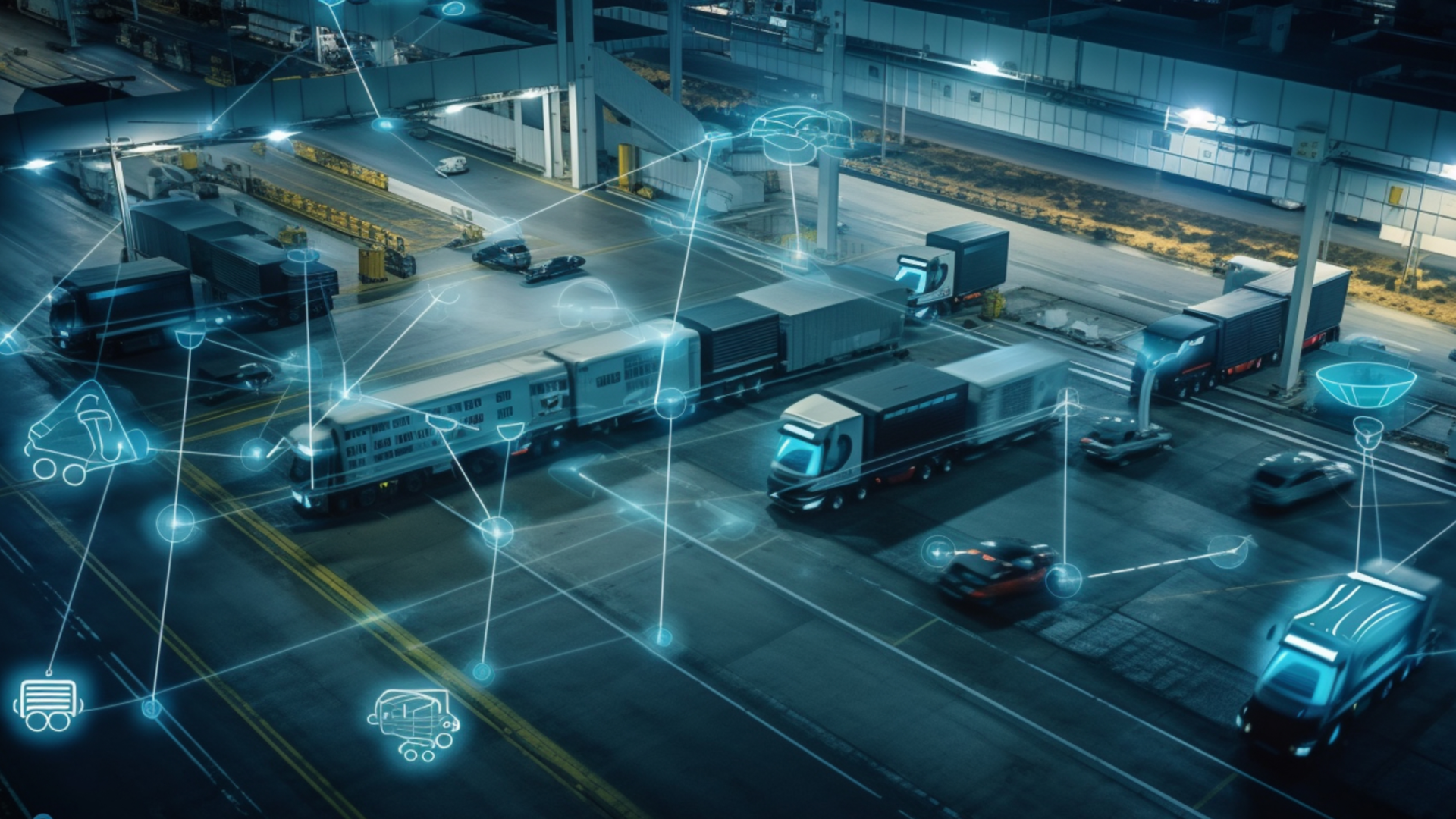The curious thing about AI in transportation and logistics is that in some cases, it’s being adopted faster by the industry collectively than by separate companies individually. That is because logistics depends on roads and urban planning, with systems implemented across an area impacting the delivery of goods for any particular company operating there. At the same time, businesses are not slacking off, either, employing AI and ML to solve their own operational hurdles.
The Role of AI and Machine Learning in Transportation
According to recent surveys, around 2/3 of decision makers in the transportation and logistics industry claim AI will be “very important” for their companies and 67% will use it within the next 5 years (with 19% already on track). Companies’ implementations are especially hinged on things like risk management, workflow management, and freight optimization, which is not surprising. Even now, artificial intelligence can reduce operating costs in logistics by up to 50%. McKinsey found that AI has so far helped companies (not just the ones specializing in logistics) improve their logistics costs by 15%, so the promise is huge for actual logistics enterprises.
All that being said, there are still factors that influence the adoption decisions, like customer service levels, analytics, predictive maintenance, and many more. So what are the general benefits of AI implementation in logistics as of 2024?
Advantages of AI in transportation and logistics
It’s important to distinguish between the concrete implementations and use cases of AI in logistics, on the one hand, and the overall benefits, on the other. What is it that artificial intelligence is intrinsically better at than the traditional tech within the industry? In other words, what are the benefits of AI in transportation and logistics? Here’s a brief overview:
- Reducing operational errors: Implementing technology to automate tasks and processes helps minimize human error, leading to more accurate and efficient operations.
- Automating manual work: By automating repetitive and time-consuming tasks, businesses can streamline workflows, increase productivity, and free up employees to focus on more strategic and creative tasks.
- Faster response time (especially in emergencies): Leveraging technology enables organizations to respond rapidly to emergencies or urgent situations, improving safety and reducing downtime.
- Smarter traffic management: Utilizing data analytics and AI-driven solutions enables smarter traffic management, optimizing routes, reducing congestion, and improving overall transportation efficiency.
- Connectivity: Interconnecting systems and devices through IoT and other connectivity solutions enhances communication, collaboration, and data sharing, leading to improved coordination and decision-making.
- Ensuring convenience (both for customers and employees): Implementing user-friendly interfaces and mobile solutions enhances convenience for both customers and employees, making processes more accessible and efficient.
- Reducing carbon emissions and ensuring fuel efficiency: Implementing technology-driven solutions such as route optimization, vehicle telematics, and alternative fuel options can help reduce carbon emissions and improve fuel efficiency, contributing to sustainability efforts.

Possible challenges
One major hurdle is the integration of artificial intelligence with existing infrastructure and legacy systems, requiring significant investment in technology and resources. Another challenge is the quality and availability of data, as AI algorithms heavily rely on large datasets to make accurate predictions and decisions.
Additionally, ensuring the security and privacy of sensitive data poses a concern, especially with the potential for cyber threats and data breaches. Moreover, there is a need for skilled personnel capable of developing, deploying, and maintaining AI systems, highlighting the importance of talent acquisition and training. Finally, regulatory compliance and ethical considerations surrounding AI implementation, particularly in autonomous vehicles and decision-making systems, add complexity to the adoption process.
Despite these challenges, overcoming them can lead to significant improvements in efficiency, safety, and sustainability within the logistics and transportation industry.
Top 10 Use Cases of Artificial Intelligence in transportation
In this section, we’ll explore some of the most compelling use cases of artificial intelligence in logistics, showcasing how innovative technologies are transforming traditional workflows and unlocking new opportunities for growth and innovation.
#1 Traffic management
This one is on top of the list for the simple reason that AI in traffic management has profound impacts for both communities and businesses. For municipalities, AI applications are now used to optimize urban mobility, reducing commuter times, traffic congestion, and environmental impact. At the same time, businesses are leveraging AI and ML to streamline operations, achieving previously unheard of levels of efficiency and accuracy in workflow management.
In practice, AI is put to the task of analyzing data from sensors, GPS, and cameras, which then can be used to reroute vehicles, warn drivers of road blockages, and generally help minimize wait times. AI-powered traffic management systems of this kind are being adopted across countries, including one in Ukraine that was developed by Lionwood.
#2 Driver monitoring
Through AI-driven technologies, such as facial recognition and behavior analysis, these systems can monitor indicators of driver fatigue, distraction, and overall attentiveness while behind the wheel. The innovative use of machine learning algorithms enables the continuous improvement of these monitoring capabilities by learning from vast datasets of driver behavior, allowing for real-time analysis and response to potential safety risks.
Statistically, the impact of AI-enabled driver monitoring systems is profound. Research indicates a significant reduction in road accidents, with some studies reporting that advanced driver-assistance systems (ADAS), which include features enabled by AI, can reduce traffic accidents by up to 29%. Moreover, the adoption of such technologies is rapidly increasing, with the global market for ADAS expected to grow from $27 billion in 2021 to over $83 billion by 2030, at a CAGR of 11.9%.
#3 Increasing ETA accuracy with artificial intelligence
Increasing the accuracy of Estimated Time of Arrivals has long been an ambition for multiple businesses, and now artificial intelligence can facilitate that. The key is in predictive analytics, helping to analyze vast amounts of data from various sources, including traffic patterns, weather conditions, and historical shipping times, forecasting delivery times with unprecedented precision.
While ETA is very commonly cited as a customer experience factor, the benefits here extend beyond just that. Research studies suggest that AI can enhance logistics performance by reducing late shipments by up to 15% and cutting down transportation costs by as much as 25%. With a more precise estimation, companies can enjoy more efficient allocation of resources, reduced operational costs, and the ability to optimize route planning. AI systems can identify potential delays in real-time and suggest alternative routes or strategies to mitigate these disruptions. Another benefit is reduced waiting times for loading and unloading, thus increasing the overall throughput of their logistics operations.
#4 Autonomous vehicles
AI-powered autonomous vehicles have been the subject of much talk recently due to their ability to navigate complex environments, avoid obstacles, and make intelligent decisions without human intervention. Of course, integrating these successfully into the supply chain brings plenty of promises, from warehousing to last-mile delivery, by reducing human error, increasing the speed of goods transportation, and operating around the clock without the need for breaks or shift changes, thus substantially enhancing productivity.
It’s estimated that autonomous technology could reduce logistics costs for long-haul shipping by up to 45% through fuel efficiency and labor savings, transforming the economic landscape of transportation. Furthermore, the global market for autonomous trucks alone is expected to grow exponentially, with projections suggesting it could reach $1.67 billion by 2025. The one question is, when will the regulatory frameworks adapt to the sufficient extent?
#5 Route optimization
Ensuring efficient delivery routes is a complex task, involving the amount and location of the necessary stops, traffic conditions, the weather, and other factors. Once these are turned into AI-digestible data sets, algorithms can provide dynamic routing options that adapt in real-time to unexpected changes (including the ever-switching demand, thus paving the way for less-than-a- truckload approach). One study showed that companies could reduce their fleet’s operational costs by approximately 10–30% using artificial intelligence for route optimization.
This kind of AI-enabled dynamic routing not only leads to significant fuel and time savings but also allows for increased delivery density and improved customer service, as deliveries become more reliable and delivery windows more accurate. A Gartner report indicates that companies employing real-time routing capabilities can experience a 15% reduction in mileage and a 20% decrease in shipping costs.
#6 Vehicle tracking in real-time
The key to tracking vehicle movement and location in real time is in most cases now the combination of AI and GPS. For example, Motor1.com reviews a range of car GPS trackers, highlighting how they serve up real-time location data alongside driving analytics and roadside assistance features. Users can view the geographical position of vehicles on a map, receive updates on driving patterns, and be alerted to maintenance needs.
Further explorations into the best car GPS trackers of 2023 by expert reviewers, such as those from U.S. News, commonly reveal functionalities that span beyond simple tracking. These devices offer features such as mileage tracking, assessment of vehicle idling patterns, and timely maintenance reminders based on the data they collect. Consistency in tracking can also help provide insights into driver behavior and contribute to better route management and increased efficiency in vehicle operations. Such trackers usually require nothing more complex than a vehicle from 1996 onwards, assuring broad compatibility.
#7 Inventory management with artificial intelligence
On the opposite side from the vehicles and routes, artificial intelligence is now increasingly used to monitor stock levels, predict demand, and facilitate timely replenishment. The data sets used need to be quite spacious, though, including historic sales patterns, market trends, seasonal variations, and supply chain dynamics. On the other hand, the benefits are considerable, from preventing stock outs to reducing overstock and risk reduction in cases with perishable items.
Ensuring product availability through predictive analytics can substantially enhance customer satisfaction and loyalty. A survey from WBR Insights and ToolsGroup involving 177 supply chain professionals found that AI and machine learning implementations had led to a 13% increase in customer satisfaction levels and a 14% reduction in inventory holdings.
#8 Predictive maintenance
AI-driven predictive maintenance systems analyze real-time data from equipment sensors and use machine learning algorithms to detect anomalies and forecast potential failures before they occur. This predictive insight allows logistics operators to perform maintenance on an as-needed basis, rather than adhering to a less efficient cyclical schedule. Consequently, this proactive maintenance minimizes unplanned downtime, extends the life span of machinery, and optimizes the deployment of maintenance resources.
Benefits of integrating AI into predictive maintenance are manifest across various key performance indicators. It can lead to a significant reduction in maintenance costs, which can account for a considerable portion of a logistics company’s operating expenses. A study by McKinsey & Company estimates that AI-enhanced predictive maintenance can lead to a 10-40% reduction in maintenance costs, 5-10% reduction in annual maintenance spending, and up to 50% decrease in downtime of equipment. These systems also contribute to a safer working environment by reducing the incidence of machine-related accidents and ensure a higher level of operational sustainability by limiting unnecessary waste of resources. Such efficiency gains underline the tremendous potential of AI in transforming maintenance strategies within the logistics sector, conjoining technological innovation with economic and safety benefits.

#9 Drone taxis
Drone taxis, also known as air taxis or urban air mobility vehicles, are on the forefront of revolutionizing urban transport by harnessing the power of Artificial Intelligence (AI). These autonomous aerial vehicles are designed to operate without a human pilot, relying on advanced AI systems for navigation, collision avoidance, takeoff, and landing. By integrating sophisticated algorithms and real-time data analysis, AI enhances the safety, reliability, and efficiency of these taxis, enabling them to adapt to the complexities of urban airspace. Moreover, air taxis promise to alleviate ground traffic congestion by opening up the skies as viable transportation routes, thereby reducing travel time for passengers. Initial tests and deployments suggest a promising future, with industry studies forecasting the urban air mobility market to surge beyond $6.63 billion by 2030, positioning AI-driven drone taxis as an eco-friendly and scalable solution for next-generation city transit.
#10 Chatbots
Conversational AI and chatbots, even though they are still somewhat associated with eCommerce and things like ChatGPT, are actually gaining traction in the logistics sector, providing streamlined interfaces that facilitate human-like interactions between users and digital systems. The reason? They can automate numerous routine tasks, such as tracking shipments, scheduling pickups, generating reports, and resolving common IT issues. Additionally, these AI-driven assistants can be embedded into internal systems to provide on-the-spot training and real-time support, leading to a more responsive and efficient work environment.
On the customer-facing side, conversational AI in logistics enhances user experiences by providing instant, round-the-clock support. Customers can inquire about shipment status, costs, estimated delivery times, and even resolve any issues via chat interfaces seamlessly integrated into websites, apps, or social media platforms.
On the marketing side, conversational AI can also gather valuable customer insights and feedback, enabling companies to continuously refine their services and stay ahead of customer expectations. An Invesp study indicates that businesses that use chatbots for customer service could save up to 30% on customer support costs, underlining the economic appeal of incorporating conversational AI solutions in logistics.
Real-World Cases of Artificial Intelligence in Logistics and Transportation Industry
What are some of the actual cases to be found in real life that can illustrate the points we’ve just made? Here are some from tech giants, but let’s not forget that AI is no longer reserved for large enterprises; in fact, these harbinger cases are just heralding the wider movement.
- Tesla. Pioneering the integration of AI technologies, Tesla’s Autopilot mode exemplifies its commitment to revolutionizing road safety and efficiency. Through a sophisticated system powered by sensors, cameras, and machine learning algorithms, Tesla vehicles equipped with Autopilot navigate surroundings autonomously, identifying obstacles and making real-time driving decisions. While at the time of its adoption (and much earlier, in fact, at the time when Google announced self-driving cars) the development was mainly associated with private vehicles, it’s even more important for logistics, promising increased safety, efficiency, and automation in fleet management and delivery operations.
- Amazon. The commercial behemoth heavily involved with logistics has leveraged AI to revolutionize its warehouse and shipping operations. Integrating robots equipped with computer vision and AI capabilities, Amazon’s warehouses optimize item picking and packing processes, augmenting human labor for enhanced efficiency and reduced errors. This AI-driven approach not only streamlines warehouse operations but also facilitates faster order fulfillment, significantly impacting logistics overall and the transportation industry in particular by setting new standards for efficiency and customer service.
- Hitachi. Hitachi’s AI Digital Fleet Solutions harness artificial intelligence (AI) algorithms and machine learning techniques to facilitate commercial fleet management. The benefits include real-time insights into vehicle performance, location, fuel consumption, and critical data, facilitating informed decision-making to increase efficiency, reduce costs, and enhance safety. With predictive modeling, Hitachi are able to anticipate maintenance issues, optimize routes, and enhance driver performance, leading to increased efficiency and lower operational costs. Additionally, real-time tracking, driver performance monitoring, and automated maintenance scheduling ensure data-driven decision-making and improved overall fleet performance.
- FedEx‘s investment in AI and machine learning through FedEx Dataworks has brought in innovations like Package Fingerprint and SenseAware have enhanced customer solutions, predictive analytics, and real-time tracking while promoting environmental sustainability. Through strategic implementation and adaptability, FedEx has not only strengthened its traditional shipping services but also expanded into new digital realms, offering valuable insights for organizations embracing AI in the modern business landscape.
Where to Start Implementing Artificial Intelligence in Logistics and Transportation
How to adopt AI in your logistics processes? It pays off to know where to start, and that’s usually the field that bothers the employees the most (as visible through HR and finance reporting). Identifying operational inefficiencies and especially human resource shortage is the first step toward using AI’s potential to automate tasks, enhance efficiency, and mitigate costs.
Of course, there are expenses along the way – namely, training the staff to use the new systems and preparing the existing IT infrastructure. Essentially, that’s why adopting AI is, for many companies, largely an outsourcing thing. Assembling a skilled team of AI strategists, engineers, data scientists, and specialists is imperative for aligning AI initiatives with business goals and developing tailored solutions, and it’s at the intersection of individual capabilities that the optimal way lies.
At Lionwood, we offer AI-powered solutions that are, by design, pinpointed to address the challenges of the logistics industry. Reach out to us today for a consultation on how best to harness the full potential of AI for your logistics operations












